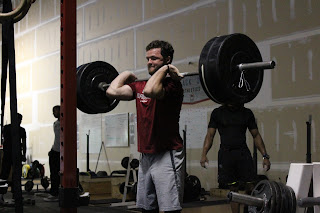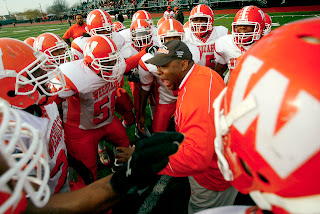Why conditioning should not be the early focus of your Off-Season Football Program?

This is a very controversial topic, but one I often encounter as a fitness professional. Some football coaches believe that if they start conditioning the team as early as possible the team will be better prepared for the season. This is not the case…we have to remember that most teams are attempting to become stronger and faster. The energy systems that most coaches use for conditioning are not applicable to football. Let’s take a look at the three energy systems and which one is used in the sport of football.
Adenosine Triphosphate, or ATP, is the immediate usable form of chemical energy for muscular activity. Any forms of chemical energy that the body gets from food must be converted into ATP before being used by muscle cells. ATP stores in muscle is limited and will deplete in 1 to 2 seconds unless restored. Resynthesis of ATP must occur immediately for muscular activity to continue. There are three systems available within the body to replace concentrations of ATP.
Anaerobic Phosphagen (ATP - CP) Energy SystemCreatine Phosphate (CP) is an energy rich compound foundin muscle cells. After high intensity exercise, creatine phosphate immediately restores ATP in the muscle without forming waste products (lactic acid). The amount of ATP that can be resynthesized from CP can last for 4 to 5 seconds. So, add that to the 1 to 2 seconds of original ATP stores within the muscle and you have about 5 to 7 seconds of ATP production from the ATP-CP Energy System.(Latif Thomas Article)
According to the USA Track and Field Level II Sport Science manual, to really challenge this system, you need workouts of 7 to 10 seconds of high intensity (sprint) work. This means running at full speed or near full speed, but with no fatigue present.'
Glycolysis literally means the breakdown (lysis) of glucose and consists of a series of enzymatic reactions. Remember that the carbohydrates we eat supply the body with glucose, which can be stored as glycogen in the muscles or liver for later use.
The end product of glycolysis is pyruvic acid. Pyruvic acid can then be either funnelled through a process called the Krebs cycle (see the Oxidative System below) or converted into lactic acid. Traditionally, if the final product was lactic acid, the process was labelled anaerobic glycolysis and if the final product remained as pyruvate the process was labelled aerobic glycolysis.
The oxidative or Aerobic system consists four processes to produce ATP:
• Slow glycolysis (aerobic glycolysis)
• Krebs cycle (citric acid cycle or tricarboxylic acid cycle)
• Electron transport chain
• Beta oxidation
Slow glycolysis is exactly the same series of reactions as fast glycolysis that metabolise glucose to form two ATPs. The difference, however, is that the end product pyruvic acid is converted into a substance called acetyl coenzyme A rather than lactic acid (5).
Let’s examine how long it takes to stay in these energy systems. The ATP + CP system lasts from 0-10 seconds, from 10 to 120 seconds glycogen is being used which may produce lactic acid(the sore feeling in the muscle), and the aerobic system kicks in from 120 seconds on. The average football play lasts about 5 seconds with 50 seconds recovery in between. However, most football coaches use gassers or sprints lasting more than 10 seconds with incomplete recoveries as their main conditioning movements, which produce LACTIC ACID.
Why is it bad to start conditioning early in the offseason? Most football players are banged up during the season and need time to heal as well as fix any muscle imbalances that might have been created during the season. We emphasize an 8 week block where we focus on bodyweight exercises, myofascial release techniques, medicine ball training, single leg exercises, low to moderate weight on main exercises, recovery methods, and balance. This block of training will help increase the cross sectional size of the muscles and help prepare the athlete for the following blocks of training ahead.
The next block of training should focus on strength & speed. If you want your athletes to be fast you must sprint maximally without being in a state of fatigue. Too much conditioning during this phase will make it hard to recover in order for athletes to lift maximally and sprint maximally. Thus affecting the overall speed development of your team. Due to time constraints, we favor sprinting maximally with complete recoveries twice during the week, and one day of general aerobic conditioning.
As you can see, we do believe in conditioning, but it has to be comparable to the sport played. Football is both anaerobic and aerobic which is why aerobic conditioning is needed. Every player must be able to recover quickly once they have made a play in order to restore their energy system and sprint again.
James Smith said, “I do see a value in increasing the cardiovascular capabilities of each athlete as it increases the mitochondria at the cellular level. This means more energy reserves.
Consider the biochemical fuel sources that mobilize alactic efforts (ATP/CP).
Those are the substrates which must be maximally replenished in order that all subsequent alactic efforts are as high in quality as possible.
Aerobic process of ATP synthesis (oxidative phosphorylation) is highly efficient and comes at a low physiological expense. This process occurs in the mitochondrion and, guess what, aerobic work increases mitochondrial density; hence more energy producing machines.
Note- the NFL players who routinely require oxygen on the sideline following drawn out interceptions, punt/kick returns, long runs, and so on. This is indicative of poor aerobic development.
Unfortunate for the athletes is that most coaches believe aerobic work will make you slow and, as a consequence, favor more 'challenging' lactic efforts to improve work capacity.”
The best way to condition the body football is to make sure the heart rate is low(130-140), develop movement efficiency & strength, enhance recovery abilities, and keep the intensity low. We favor jogging at 60 to 65% intensity about 50 yards performing a low intensity exercise, jogging again at 60 to 65% and performing another exercise, and continuing until you have completed 2 to 3 laps around the football field. This is a great filler in between speed or maximal effort lifting days as no lactic acid is produces, the aerobic energy system is being developed, muscles are being strengthened, and blood is flushing out any toxins in the body to enhance recovery. It’s a win-win in my book. As we get closer to the season we start to add more conditioning into our program and increase the intensity. The intensity and conditioning really becomes the focus of the program around 8 weeks before pre-season practice.
This gives the coach plenty of time to improve the conditioning levels of the athlete. What coaches must be careful with is to make sure they are decreasing the amount of maximal weight they are lifting and the amount of speed training they are doing? You cannot continue to make progress using one energy system if you also are raising the volume in another energy system. You must see the body as a see-saw. If one area’s intensity goes up the other’s must come down. Some examples of conditioning we do in this intense period are 30-50 yard sprints with low recovery periods, push the prowler, sled dragging, band resisted sprinting, etc…




Comments
Post a Comment